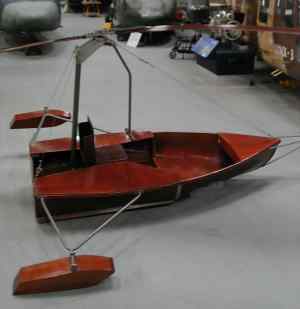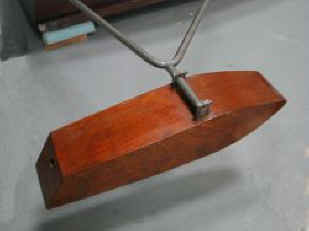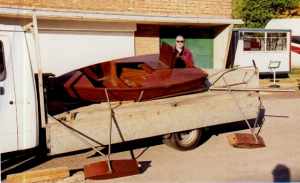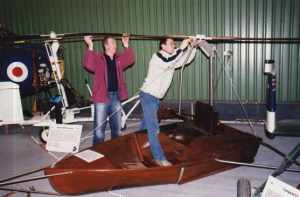Bensen B-8B Gyro-Boat
 |
Igor Bensen, a Russian immigrant to the United States, formed the Bensen Aircraft Corporation in Raleigh, North Carolina, in 1953. From 1954, inspired by Raoul Hafner's 1942 Rotachute, he designed and built a series of gyro-gliders and powered gyrocopters. The most successful was the B-8 which was developed in many powered and unpowered versions, in factory-built and do-it-yourself kit form. The Bensen B-8M, powered by one 173cc Victa Pixie two-stroke piston engine, which is on show (left) in the Helicopter Museum, was built near Bristol, in the UK, by Keith Brittan, in the 1980s. His machine was underpowered and never flew. | ||||||||
| Bensen had
become the largest manufacturer of light gyrocopters and gyro-gliders
by 1956 when he developed the B-8B Gyro-Boat. The original and basic,
unpowered, two-bladed rotor system, with "overhead stick"
control, was adapted for mounting on a fairly conventional dinghy
or rowboat which was equipped with twin, outrigged, stabilising floats. The Gyro-Boat was flown by towing it behind a motorboat at about 45km/h, using a flexible, steel cable. The Museum example (right) was assembled and test flown in the late 1950s, in Glasgow for purchase by a Mr McGill whose son, Gordon, flew it once on Loch Lomond. It was restored by Gordon McGill, in the 1990s, and given to the Brooklands Museum, who transferred it to The Helicopter Museum in October 2003 |
 |
||||||||
 |
 |
||||||||
| Gyro-Boat starboard stabliser float | Gyro-Boat rotor head | ||||||||
| |||||||||

